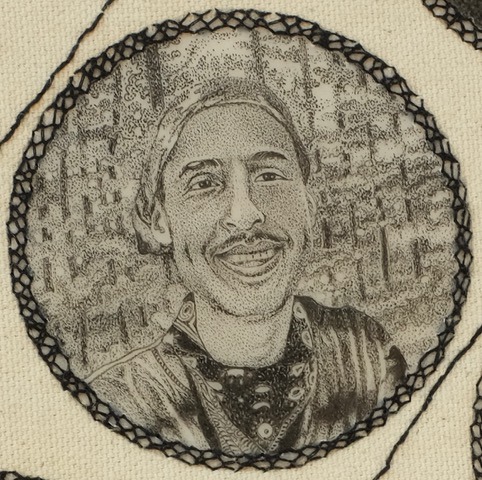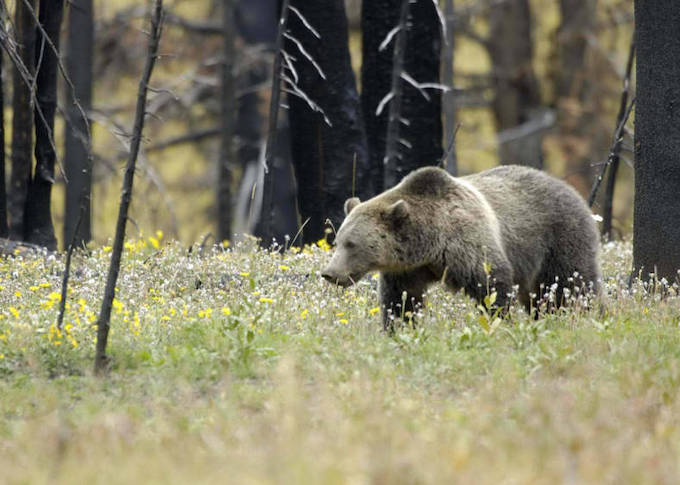
Manuel Téran. Image: Priti Gualati Cox.
Along the South River, in the southwest corner of DeKalb County, Georgia, lies a forested area of about 300 acres that has been owned by the nearby City of Atlanta for over a century. It was once part of a vastly larger wooded landscape, home to the Muskogee (Creek) people. They gave the river and forest the name “Weelaunee.”
In 2021, Atlanta officials decided to split 85 acres off this remnant of the Weelaunee forest and lease it to the Atlanta Police Foundation, a nonprofit organization, for construction of a $90 million tactical training center. If built, it will be one of the country’s largest such facilities and include an entire “mock village” in which cops can practice doing the kinds of things cops do.
For the past two years, a broad, loose coalition comprising neighborhood associations, schools, environmental groups, justice activists, civic leaders, and forest defenders has been pushing back hard against what they call “Cop City”. Writing for Atlanta magazine in January, Timothy Pratt captured the sheer breadth of the coalition’s motives and goals:
These disparate groups have in common opposition to the training center, with sometimes differing rationales. Some see the importance of preserving intact forests, as ecosystems, amid a climate crisis increasingly being felt in the Southeast—but may support building the training center elsewhere. Some worry about further contaminating a forest and river that are already contaminated. Others question the wisdom of investing tens of millions of public dollars in policing—particularly to build a training center in a majority-Black area that has seen decades of disinvestment. Yet others see a connection between environmental contamination and the neglect of majority-Black neighborhoods in the Atlanta metro, concerns exacerbated by a haphazard process for collecting public input on the proposed facility. At the center of it all is a piece of land that has already endured centuries of contesting visions for what people in Atlanta, particularly Black people, need and deserve.
Two months later, in The Guardian, Pratt reported on a media blitz by city officials scrambling to build support for the training center—an effort that ran head-on into a surge of resistance by community members and groups. Will Potter, the author of Green Is the New Red: An Insider’s Account of a Social Movement Under Siege, was also in Atlanta to follow the struggle, and told Pratt, “You get the feeling everybody is talking about this; everybody knows it’s going on. It’s like the issue has saturated the public discourse; it’s permeated everywhere.”
Meanwhile, forest defenders have camped and protested, both under and up in the trees, for more than a year, while enduring repeated police raids and the killing by police of one of their own: Manuel Paez Terán, a Venezuelan eco-activist known as Tortuguita (“Little Turtle”), in January. During protests prompted by Tortuguita’s killing, dozens of forest defenders have been arrested on state “domestic terrorism” charges, 23 of them during a concert.
A position statement by Defend the Atlanta Forest, a self-described “autonomous movement for the future of South Atlanta” captures the tangle of issues at the heart of the defenders’ struggle:
The fight[s] against ecological destruction and racialized violence in Atlanta, and beyond, are inextricably linked. Today, climate collapse disproportionately affects disadvantaged groups such as Atlanta’s Black communities. Rather than investing in solutions to the environmental crisis, governments are investing in heavier policing, especially of those disadvantaged groups. Atlanta’s tree canopy is one of its main sources of resiliency in the face of climate change. [But] rather than address the problems as they really present themselves, world and local leaders are hurling us into the fire. As we fight for a life worth living, the system seems prepared to prop up its petroleum-based economy with tear gas and lines of riot police.
Colonialism, then and now
Through the 18th and early 19th centuries, first the English and then US settlers encroached on millions of acres of Muskogee lands across a broad swath of Florida and Georgia that included the Weelaunee forest. Then, about 200 years ago, the federal government seized all of the Muskogee territory outright. The stolen forest was soon converted to a plantation worked first by enslaved labor and later through sharecropping. In 1922, the plantation owners sold the property to the City of Atlanta. On it, the city built a “prison farm” where inmates would grow food for their fellow incarcerated people. The farm, notorious for abuse of prisoners, especially Black prisoners, operated all the way up to 1990, when it was abandoned. The forest has since reclaimed the acreage, thanks to the Southeast’s favorable climate for lush plant growth. But now, if Cop City is built, the long, cruel, racist history of this plot of land will soon take up where it left off three decades ago.
Plans for Cop City emerged from a corporate process, not a democratic one. Of its entire cost, two-thirds, $60 million, has been pledged by the Atlanta Police Foundation, whose board of directors is drawn from a who’s who of Atlanta-based corporations, including Delta Airlines, Waffle House, Home Depot, Georgia Pacific, Equifax, Accenture, Wells Fargo, and UPS. Morgan Simon, a senior contributor to Forbes, has compiled a list of some of the major Atlanta-area donors supporting the branch of the foundation that, it appears, will be funding Cop City. Among them are Chick-fil-A, Coca-Cola, UPS, Gas South (which sells fossil gas in Georgia, Florida, North Carolina, South Carolina, Ohio, and New Jersey), Georgia Pacific (which grinds up zillions of trees to make paper pulp), Rollins Inc. (which performs chemical pest control), and Norfolk Southern Railway (which delivered clouds of hydrogen chloride and phosgene to East Palestine, Ohio, with its catastrophic derailment in February). With eyebrows raised, Simon notes that four of the Cop City funders—Chick-fil-A, UPS, Coca-Cola, and Norfolk Southern— “all made prior racial equity commitments in the wake of George Floyd’s murder.”
If the project comes to fruition, this corporate investment in police militarization will have heavy ecological consequences. In 2021, the Georgia chapter of the Sierra Club and 15 other environmental justice groups sent a letter to Mayor Keisha Lance Bottoms and the Atlanta City Council opposing construction of the facility. The letter charged that, among other impacts, it would release into the atmosphere large amounts of carbon that the forest ecosystem has been capturing from the air and storing for decades. It would also, they wrote, “leave the surrounding areas susceptible to stormwater flooding, which is Atlanta’s top natural disaster, continually increasing in intensity due to climate change.” And, the letter said, by bulldozing a significant portion of the forest and draining wetlands within it, the project would imperil “one of the last breeding grounds for many amphibians in the region, as well as an important site for migratory and wading birds.” As a further consequence, research shows, environmental injustice will reverberate far beyond the Cop City construction site.
Urban forests and climate justice
Atlanta, which has more tree cover than any other major US city, has been nicknamed “the city in a forest.” But today, its wooded areas are under constant pressure from development. Cutting down and paving over a chunk of Atlanta’s largest forest to build something akin to a movie set for ersatz urban conflict would deal a huge blow to the livability of the surrounding area. And that blow would land hardest on marginalized communities. A 2017 meta-analysis of 40 academic research reports on the relationship between urban forests and race found that predominantly Black residential areas had more tree cover on private property than other areas, suggesting that perhaps “minority residents have a stronger preference for vegetation than other groups.” However, Black neighborhoods tended to have much less tree cover on their public land, suggesting that decisions by municipal policymakers tend to produce “inequity in public service provision.” Through historical happenstance, the predominantly Black neighborhoods around the Weelaunee forest fragment, having an unusually large public urban forest close by, are a sharp exception to that trend. Now that prized local asset is under threat.
The neighborhoods are not so lucky in other respects. More than one-fourth of the residents live in poverty. In the vicinity are six landfills, five prisons, the ruins of now-demolished public housing, and a lot of dirty industry. Given that, the forest is all the more a local treasure; the last thing residents want is to see it partially destroyed to build Cop City.
Weelaunee and other urban forests are crucial to environmental justice, and in the hot, humid Southeast, to climate justice in particular. In all but six of the 175 most populous cities of the United States, the average person of color endures more intense summer heat than the average non-Latino white person. Overall, Black residents are hit by more than twice the urban heat impact that white residents endure. And it’s getting worse. Dr. Brian Stone, an urban-planning professor at Georgia Tech, told Atlanta magazine models predict that with global climate change, by 2030 heat waves like the historic one that hit Atlanta in 1995 will be “fairly routine—we’ll probably see it every couple of years, instead of every 10 or 20 years.”
Stone says that an electrical grid failure coinciding with an intense heat wave “is probably the deadliest climate-related event we can imagine in the United States.” He estimates that if a blackout hits during a heat wave as severe as the one endured in 1995, fully 70 percent of Atlanta’s population would experience life-threatening indoor temperatures. The paucity of facilities to provide relief for people with inadequate housing, or none at all, would further heighten the peril. There are only five public cooling centers in the entire city, the magazine noted, and they aren’t required to have backup power generators.
With those dangers looming, the last thing the people of southeast Atlanta and southwest DeKalb County need is local deforestation. Dr. Cassandra Johnson Gaither, who researches the relationship between social vulnerability and resource use for the US Forest Service in Georgia, says, “Cities are hotter than surrounding areas because of the urban heat island effect, so the more green tree canopy you have, the more cooling there is for homes and people.” In a 2021 report, scientists at Yale University and Imperial College London concluded, “Maintenance and expansion of urban forests rather than generic urban greening is . . . a key factor for mitigating” urban summer heat. Urban trees have been shown to dramatically reduce summer temperatures, cutting by 7 percent the amount of energy required to cool US homes. That saves households $7.8 billion annually while reducing greenhouse-gas emissions.
Johnson Gaither points out that “urban forests also act as a check on the constant stream of pollutants being emitted in the surrounding area, and studies have shown that has human health benefits.” More generally, she adds, “The more trees you have in the surrounding area, the better people’s physical and mental health is. Just being near trees, near urban green spaces, research shows, has calming effects.” Researchers at North Carolina State University have indeed found that spending time in places like urban forests improves mental health.
Can Cop City be stopped?
Before the Weelaunee forest was targeted by the police foundation, a coalition of southwest DeKalb County residents and environmental, civic, and community groups had begun urging the establishment of a conservation area 10 times larger, which they would call the South River Forest. The project, still aspirational, would expand and interconnect the forest, five existing public parks, and some well-wooded neighborhoods, all of them in that corner of the county. The coalition, of course, opposes having the police facility plopped down in the midst of the Weelaunee forest, which they envision as the biggest gem in an “emerald necklace of connected public greenspaces” bordering economically distressed southeast Atlanta.
The original plan for Cop City called for a 150-acre site, notes Atlanta’s Pratt, but community opposition early on managed to get the plan whittled down to the current 85 acres. The South River Forest Coalition, the forest defenders, and other groups are carrying on the struggle to push the acreage all the way down to zero and scuttle the Cop City idea entirely. But others see the project, with its heavy backing from City Hall and big business, as an inevitability that will just have to be reckoned with. The goals then would come down to limiting damage to the local environment and quality of life in surrounding neighborhoods. while carrying on the long struggle against systemic racism, rights abuses, and the culture of killing in the police department.
I asked Johnson Gaither what the consequences would be, for both the forest and its human neighbors, if a fate that some now see as unavoidable does come to pass. With Cop City occupying almost 30 percent of the forest’s current acreage, won’t the ecological integrity of the entire area be undermined?
“Yeah,” she said, “that’s sort of the 64-million-dollar question, isn’t it?” Given that uncertainty, she added, some in the local community are just trying to limit the damage, whatever it may be: “I understand that groups of residents have been organizing, requesting that buffers be added around the new training facility. They’ve been in constant dialogue with the police to say, ‘Well, if you want to expand this, and it’s on this 85 acres, and we have to live right next to it, this is what we want, so that the impacts are reduced.’”
Meanwhile, the broader groundswell against Cop City appears more energized than ever, so maybe, when this is all over, the trees will live on and no buffers will be needed.
A version of this essay first appeared on the In Real Time blog published by City Lights.



